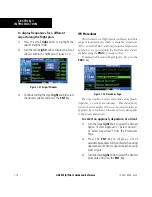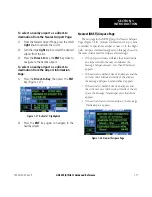
GNS 430(A) Pilot’s Guide and Reference
190-00140-00 Rev. P
SECTION 3
NAV PAGES
3-1
SECTION 3: NAV PAGES
3.1 MAIN PAGE GROUPS
The GNS 430’s main pages are divided into four
separate
page groups: NAV, WPT, AUX, and NRST
(Table 3-1). Each page group is comprised of multiple
pages. The page groups are selected using the large
right
knob. The individual pages are selected using the small
right
knob.
Page Groups
NAV Group WPT Group AUX Group NRST Group
7 NAV Pages see Section 7 see Section 10 see Section 8
Table 3-1 Page Groups
The bottom right corner of the screen (Figure 3-1)
indicates which page group is currently being displayed
(e.g., NAV, WPT, AUX, or NRST), the number of screens
available within that group (indicated by the square icons),
and the placement of the current screen within that group
(indicated by a highlighted square icon).
The bottom right corner of the screen is also used to
display the GNS 430’s turn advisories (Turn to 230º’) and
waypont alerts (‘Next DTK 230º’) during flight plan and
approach operations. (See Section 6.)
Figure 3-1 Current Page and Page Group
Current Page Group
Number of Pages in
Current Page Group
Position of
Current Page
within Current
Page Group
To select the desired page (from any page):
1) Press and hold the
CLR
Key to select the
Default NAV Page. Turn the large
right
knob
to select the desired page group.
2) Turn the small
right
knob to select the desired
page.
NOTE: The NAV Page Group may have eight or
nine NAV pages when the GNS 430 is connected
to Traffic and/or weather information sources.
See Section 12 for more information.
3.2 NAV PAGE GROUP
The
NAV Page Group includes seven pages (Figure
3-2). While viewing any NAV page, turn the small
right
knob to select a different NAV page. The pilot may find
this selection process convenient to cycle between the
Default NAV Page and the Map Page, which are two of
the most frequently used pages. Other pages are provided
for terrain information (if configured for TERRAIN), to
list frequencies for the flight plan, to show the current
position, to display current satellite reception, and to
make vertical navigation settings.
Default NAV
Map
TERRAIN
NAV/COM
Position
Satellite Status
VNAV
(if configured)
Figure 3-2 NAV Pages
Summary of Contents for GNS 430
Page 1: ...GNS 430 A Pilot s Guide and Reference ...
Page 2: ......
Page 116: ...GNS 430 A Pilot s Guide and Reference 190 00140 00 Rev P SECTION 6 PROCEDURES 6 34 Blank Page ...
Page 265: ......






























